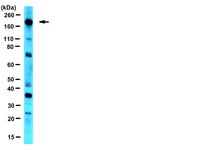07-1800 Sigma-AldrichAnti-eIF4G Antibody
Anti-eIF4G Antibody is an antibody against eIF4G for use in WB & IF.
More>> Anti-eIF4G Antibody is an antibody against eIF4G for use in WB & IF. Less<<Recommended Products
Overview
| Replacement Information |
|---|
Key Spec Table
| Species Reactivity | Key Applications | Host | Format | Antibody Type |
|---|---|---|---|---|
| H, M | WB, IF | Rb | Serum | Polyclonal Antibody |
| References |
|---|
| Product Information | |
|---|---|
| Format | Serum |
| Presentation | Rabbit polyclonal serum with 0.05% NaN3. |
| Quality Level | MQ100 |
| Applications | |
|---|---|
| Application | Anti-eIF4G Antibody is an antibody against eIF4G for use in WB & IF. |
| Key Applications |
|
| Physicochemical Information |
|---|
| Dimensions |
|---|
| Materials Information |
|---|
| Toxicological Information |
|---|
| Safety Information according to GHS |
|---|
| Safety Information |
|---|
| Storage and Shipping Information | |
|---|---|
| Storage Conditions | Stable for 1 year at -20ºC from date of receipt. |
| Packaging Information | |
|---|---|
| Material Size | 100 µL |
| Transport Information |
|---|
| Supplemental Information |
|---|
| Specifications |
|---|
| Global Trade Item Number | |
|---|---|
| Catalogue Number | GTIN |
| 07-1800 | 04053252514302 |
Documentation
Anti-eIF4G Antibody SDS
| Title |
|---|
Anti-eIF4G Antibody Certificates of Analysis
| Title | Lot Number |
|---|---|
| Anti-eIF4G - 2136650 | 2136650 |
| Anti-eIF4G - 2147096 | 2147096 |
| Anti-eIF4G - 2272139 | 2272139 |
| Anti-eIF4G - 2320067 | 2320067 |
| Anti-eIF4G - 3437952 | 3437952 |
| Anti-eIF4G - NG1607753 | NG1607753 |
| Anti-eIF4G -2604210 | 2604210 |
| Anti-eIF4G -2817712 | 2817712 |
| Anti-eIF4G Polyclonal Antibody | 2988814 |
| Anti-eIF4G Polyclonal Antibody | 2951432 |
















